计算理论02_正则语言
计算理论习题答案CHAP3new
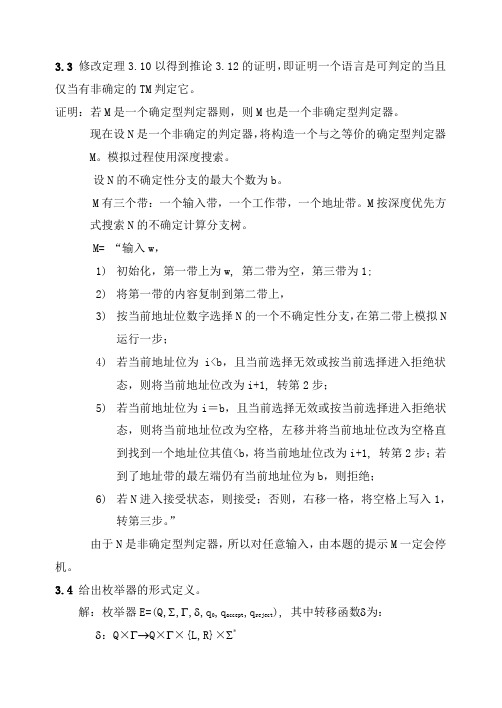
3.3 修改定理3.10以得到推论3.12的证明,即证明一个语言是可判定的当且仅当有非确定的TM判定它。
证明:若M是一个确定型判定器则,则M也是一个非确定型判定器。
现在设N是一个非确定的判定器,将构造一个与之等价的确定型判定器M。
模拟过程使用深度搜索。
设N的不确定性分支的最大个数为b。
M有三个带:一个输入带,一个工作带,一个地址带。
M按深度优先方式搜索N的不确定计算分支树。
M= “输入w,1)初始化,第一带上为w, 第二带为空,第三带为1;2)将第一带的内容复制到第二带上,3)按当前地址位数字选择N的一个不确定性分支,在第二带上模拟N运行一步;4)若当前地址位为i<b,且当前选择无效或按当前选择进入拒绝状态,则将当前地址位改为i+1, 转第2步;5)若当前地址位为i=b,且当前选择无效或按当前选择进入拒绝状态,则将当前地址位改为空格, 左移并将当前地址位改为空格直到找到一个地址位其值<b,将当前地址位改为i+1, 转第2步;若到了地址带的最左端仍有当前地址位为b,则拒绝;6)若N进入接受状态,则接受;否则,右移一格,将空格上写入1,转第三步。
”由于N是非确定型判定器,所以对任意输入,由本题的提示M一定会停机。
3.4给出枚举器的形式定义。
解:枚举器E=(Q,∑,Γ,δ,q0,qaccept,qreject), 其中转移函数δ为:δ:Q×Γ→Q×Γ×{L,R}×∑*δ (q,a)=(r,b,s1,c)表示若E处于状态q,且在工作带上读到a,则状态转移为r,当前格改写为b并按s1作相应左或右移,打印带上写下字符串c,其中若c等于ε,则不打印。
另外E的起始格局只能是qv,这里v表示一个空格。
3.5检查图灵机的形式定义,回答下列问题并解释你的推测:a.图灵机能在它的带子上写下空白符吗b.带字母表Γ和输入字母表∑能相同吗?c.图灵机的读写头能在连续的两步中处于同一个位置吗?d.图灵机能只包含一个状态吗?解:a.能。
第三章(续二)正则语言性质
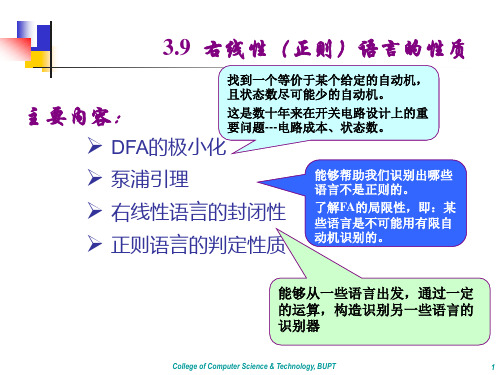
B
确定有限自动机DFA的化简(极小化)
对DFA M的极小化是找出一个状态数比M少的 DFA M1,使满足 L(M) = L(M1) 1.状态等价和可区分的概念 设DFA M = (Q,T,δ,q0,F) 对不同的状态q1, q2∈Q 和每个ω∈T*, 如果有 (q1,ω)┣* (q,ε) 必有 (q2,ω)┣* (q,ε) 且q∈F , 则称q1与q2状态等价. 记为q1≡q2 否则,称q1, q2可区分.
11
通过合并等价的状态进行 DFA 的优化
举例
a Start 1 a b b 3 b
a a Start [1] a b b [3] b a b [5] [6] b [4] a
a 6 b b 5 b
4 a a
a
– 等价的状态偶对为: (1, 2),(6, 7)
7
a 2 b
– 划分结果: { 1, 2 }, {3}, {4}, {5}, { 6, 7 }
14
针对正则语言的 Pumping 引理
正则语言应满足的一个必要条件
用于判定给定的语言不是正则集。
物理意义:当给定一个正则集和该集合上一个足够长的字符串 时,在该字符串中能找到一个非空的子串,并使子串重复,从
而组成新的字符串。该新串必在同一个正则集内。
定理:
设L是正则集,存在常数k,对所有字符串ω∈L 且|ω|≥k ,则ω可写成ω1ω0ω2,其中|ω1ω0|≤k, |ω0|>0,对 所有的i≥0有ω1ω0iω2∈L。 证明 设 L 是 DFA D = (Q, T, , q0 , F ) 的语言, 取 k = |Q| 即 可. • College of Computer Science & Technology, BUPT
计算机考博试题计算理论及答案
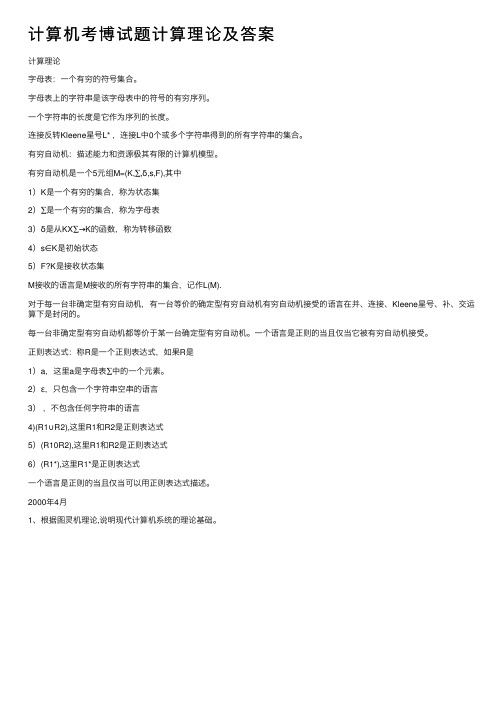
计算机考博试题计算理论及答案计算理论字母表:⼀个有穷的符号集合。
字母表上的字符串是该字母表中的符号的有穷序列。
⼀个字符串的长度是它作为序列的长度。
连接反转Kleene星号L* ,连接L中0个或多个字符串得到的所有字符串的集合。
有穷⾃动机:描述能⼒和资源极其有限的计算机模型。
有穷⾃动机是⼀个5元组M=(K,∑,δ,s,F),其中1)K是⼀个有穷的集合,称为状态集2)∑是⼀个有穷的集合,称为字母表3)δ是从KX∑→K的函数,称为转移函数4)s∈K是初始状态5)F?K是接收状态集M接收的语⾔是M接收的所有字符串的集合,记作L(M).对于每⼀台⾮确定型有穷⾃动机,有⼀台等价的确定型有穷⾃动机有穷⾃动机接受的语⾔在并、连接、Kleene星号、补、交运算下是封闭的。
每⼀台⾮确定型有穷⾃动机都等价于某⼀台确定型有穷⾃动机。
⼀个语⾔是正则的当且仅当它被有穷⾃动机接受。
正则表达式:称R是⼀个正则表达式,如果R是1)a,这⾥a是字母表∑中的⼀个元素。
2)ε,只包含⼀个字符串空串的语⾔3),不包含任何字符串的语⾔4)(R1∪R2),这⾥R1和R2是正则表达式5)(R10R2),这⾥R1和R2是正则表达式6)(R1*),这⾥R1*是正则表达式⼀个语⾔是正则的当且仅当可以⽤正则表达式描述。
2000年4⽉1、根据图灵机理论,说明现代计算机系统的理论基础。
1936年,图灵向伦敦权威的数学杂志投了⼀篇论⽂,题为《论数字计算在决断难题中的应⽤》。
在这篇开创性的论⽂中,图灵给“可计算性”下了⼀个严格的数学定义,并提出著名的“图灵机”(Turing Machine)的设想。
“图灵机”不是⼀种具体的机器,⽽是⼀种思想模型,可制造⼀种⼗分简单但运算能⼒极强的计算机装置,⽤来计算所有能想像得到的可计算函数。
这个装置由下⾯⼏个部分组成:⼀个⽆限长的纸带,⼀个读写头。
(中间那个⼤盒⼦),内部状态(盒⼦上的⽅块,⽐如A,B,E,H),另外,还有⼀个程序对这个盒⼦进⾏控制。
第4章正则语言的性质讲解

证法2: 设L由正则表达式r定义,对r的构造次数进行归纳证明: (1)设r的构造次数为0,即r是,或者a,则R=, {}R={},{a} R={ a},此时rR和r相同。 (2)设定理在r的构造次数小于k时成立,讨论r的构造次数 等于k时, 情况① 设r=r1+r2,其中r1和r2的构造次数都小于k, 由归纳假设,可以构造r1R和r2R,使得L(r1R)=L(r1)R, L(r2R)=L(r2)R, 因为L(r)=L(r1)L(r2),所以L(r)R=L(r1)R L(r2)R, 因此r1R + r2R就是代表L(r)R的正则表达式。 情况② 设r=r1r2,其中r1和r2的构造次数都小于k, 由归纳假设,可以构造r1R和r2R,使得L(r1R)=L(r1)R, L(r2R)= L(r2)R, 由于L(r)=L(r1)L(r2),因此L(r)R=L(r1)R L(r2)R,所以r1Rr2R就 是代表L(r)R的正则表达式。
0
q
它把上图中的终结状态变为非
0
1
q
q
1
2
终结状态,非终结状态变为终
0
结状态。 1
4
定理4.3 如果L1和L2是正则语言,则L1∩L2是正则语言。 证明: 用构造证明的方法: 设L1=L(M1),L2=L(M2), 其中DFA M1=(Q1,,1,q0,F1),
DFA M2=(Q2,,2,p0,F2), 构造DFA M=(Q1Q2,,,<q0,p0>,F1 F2) , 其中δ:(Q1Q2)Q1Q2 对 p1Q1,p2Q2,a (<p1,p2>,a)=< 1(p1,a),2(p2,a)>, 由定义可以看出,w被M接受当且仅当w同时被M1和M2接 受,因此,L1∩L2是正则的。
《计算理论》复习题总结
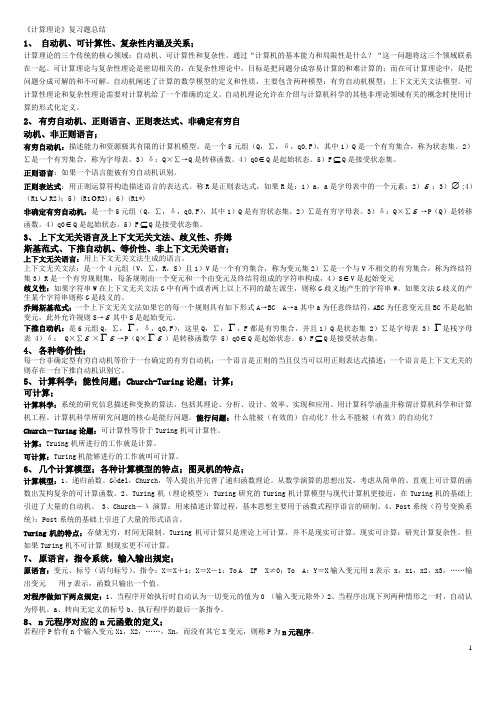
《计算理论》复习题总结1、自动机、可计算性、复杂性内涵及关系;计算理论的三个传统的核心领域:自动机、可计算性和复杂性。
通过“计算机的基本能力和局限性是什么?“这一问题将这三个领域联系在一起。
可计算理论与复杂性理论是密切相关的,在复杂性理论中,目标是把问题分成容易计算的和难计算的;而在可计算理论中,是把问题分成可解的和不可解。
自动机阐述了计算的数学模型的定义和性质,主要包含两种模型:有穷自动机模型;上下文无关文法模型。
可计算性理论和复杂性理论需要对计算机给了一个准确的定义。
自动机理论允许在介绍与计算机科学的其他非理论领域有关的概念时使用计算的形式化定义。
2、有穷自动机、正则语言、正则表达式、非确定有穷自动机、非正则语言;有穷自动机:描述能力和资源极其有限的计算机模型。
是一个5元组(Q,∑,δ,q0,F),其中1)Q是一个有穷集合,称为状态集。
2)∑是一个有穷集合,称为字母表。
3)δ:Q×∑→Q是转移函数。
4)q0∈Q是起始状态。
5)F⊆Q是接受状态集。
正则语言:如果一个语言能被有穷自动机识别。
正则表达式:用正则运算符构造描述语言的表达式。
称R是正则表达式,如果R是:1)a,a是字母表中的一个元素;2)ε;3)∅;4)(R1⋃R2);5)(R1 R2);6)(R1*)非确定有穷自动机:是一个5元组(Q,∑,δ,q0,F),其中1)Q是有穷状态集。
2)∑是有穷字母表。
3)δ:Q×∑ε→P(Q)是转移函数。
4)q0∈Q是起始状态。
5)F⊆Q是接受状态集。
3、上下文无关语言及上下文无关文法、歧义性、乔姆斯基范式、下推自动机、等价性、非上下文无关语言;上下文无关语言:用上下文无关文法生成的语言。
上下文无关文法:是一个4元组(V,∑,R,S)且1)V是一个有穷集合,称为变元集2)∑是一个与V不相交的有穷集合,称为终结符集3)R是一个有穷规则集,每条规则由一个变元和一个由变元及终结符组成的字符串构成,4)S∈V是起始变元歧义性:如果字符串W在上下文无关文法G中有两个或者两上以上不同的最左派生,则称G歧义地产生的字符串W。
正则语法 且-概述说明以及解释
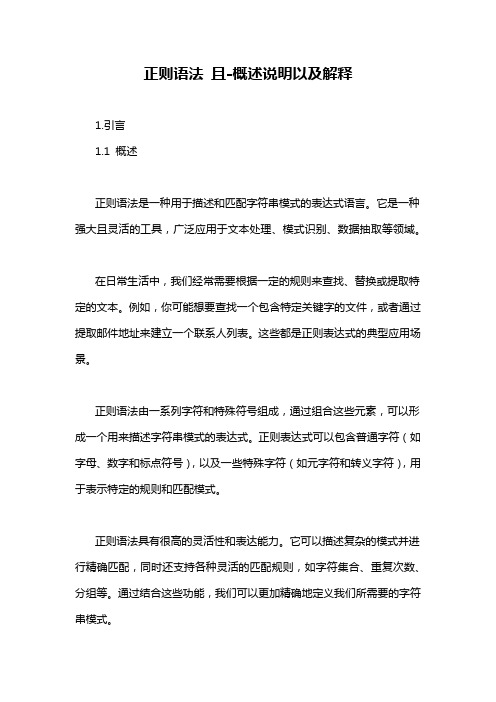
正则语法且-概述说明以及解释1.引言1.1 概述正则语法是一种用于描述和匹配字符串模式的表达式语言。
它是一种强大且灵活的工具,广泛应用于文本处理、模式识别、数据抽取等领域。
在日常生活中,我们经常需要根据一定的规则来查找、替换或提取特定的文本。
例如,你可能想要查找一个包含特定关键字的文件,或者通过提取邮件地址来建立一个联系人列表。
这些都是正则表达式的典型应用场景。
正则语法由一系列字符和特殊符号组成,通过组合这些元素,可以形成一个用来描述字符串模式的表达式。
正则表达式可以包含普通字符(如字母、数字和标点符号),以及一些特殊字符(如元字符和转义字符),用于表示特定的规则和匹配模式。
正则语法具有很高的灵活性和表达能力。
它可以描述复杂的模式并进行精确匹配,同时还支持各种灵活的匹配规则,如字符集合、重复次数、分组等。
通过结合这些功能,我们可以更加精确地定义我们所需要的字符串模式。
在本文中,我们将深入探讨正则语法的定义与作用,介绍正则表达式的基本语法,以及探讨正则语法在不同领域的应用和优缺点。
通过学习和理解正则语法,我们可以更好地处理和操作文本数据,提高工作效率和准确性。
让我们开始探索正则语法的奥秘吧!1.2 文章结构文章结构的部分应该包括对整篇文章的组织和结构进行介绍。
在这部分,我们可以讨论文章的主要部分、章节和子章节的划分方式,以及每个部分的主要内容和功能。
在本文中,文章结构可以按照以下方式进行描述:文章的主要结构由三个章节构成,分别是引言、正文和结论。
引言部分在文章开始时引入了正则语法的主题,并介绍了本文的目的和概述。
它帮助读者了解正则语法的重要性和应用领域,并为后续的正文部分奠定了基础。
正文部分是整篇文章的核心部分,主要讨论了正则语法的定义与作用以及正则表达式的基本语法。
在2.1小节中,我们将详细介绍正则语法的定义和其在编程和文本处理中的作用。
我们可以阐述正则表达式在字符串匹配、搜索和替换等方面的应用,并给出实际的例子来说明其使用方法和效果。
第三章 正则语言
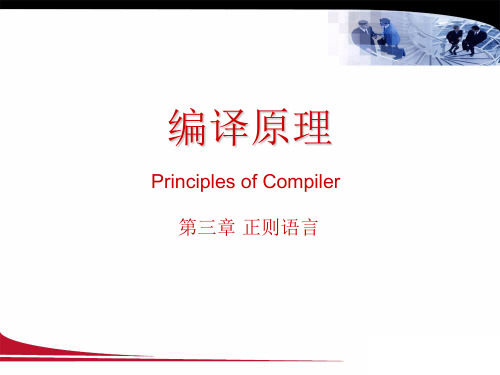
不存在M的运行s0, s1,...sn使得s0 = q0 sn F 0 i < n( (si, ai +1)= si +1)
情况:sn F 1 情况2 k (0 k n tQ((sk ,ak 1,t) ))) :
3.3 非确定性的有穷自动机
在FA的计算过程中,有的时候需要“猜测”的功 能
FA M的语言L(M)为所有M接受的串的集合。
FA的语义( FA与语言的关系 )
例:
0 1
0 0 1 1 1 2
FA与正则语言
定义:称FA M识别语言L,如果M恰好接受L中的 所有串。 定义:一个语言是正则的,当且仅当存在一台FA 识别它。
3.2 正则语言的封闭性
正则语言在并运算下的封闭性 定理:如果L1与L2为正则语言,则L1L2也是正则 语言。
语义:归纳定义 如果R为一个正则表达式,那么R的语言L(R)可以 归纳定义如下:
– – – – – – L(a) = {a} L(e) = {e} L() = L(R1 | R2) = L(R1) L(R2) L(R1 ·R2) = L(R1) ·L(R2) L(R1* ) = L(R1)*
3.3.1 NFA的形式定义
表格表示方法
0,1 0,1
q1
1
q2
0,e
q3
1
q4
q1 q2 q3 q4
0 {q1} {q3} {q4}
1 {q1,q2} {q4} {q4}
e
{q3}
3.3.2 NFA的语言
NFA的运行:
– M的一个运行是一个有穷的状态序列 = s0s1…sn, 其中:
– 证明思路:构造一台FA恰好识别L1L2。
正则语言——精选推荐

第 4 章正则语言的性质本章中我们将会探讨正则语言的性质,在此过程中我们所使用的第一个工具是一个定理,它能够证明某个语言不是正则的。
该定理叫做“泵引理”,我们将在第4.1节中介绍它。
正则语言的一类很重要的性质是“闭包性质”,该性质使得我们能够从一些语言出发,通过一定的运算符,来构造能够识别另一些语言的自动机。
例如,两个正则语言的交仍然是正则语言。
因此,给定能够识别两个不同的正则语言的自动机,我们可以机械地构造一个恰好识别这两个语言的交的自动机。
由于这样构造出来的自动机可能比给定的两个自动机的状态都多,因此这种“闭包性质”可以作为一种构造复杂的自动机的工具。
第2.1节中用很实质的方式使用了这种构造过程。
正则语言的另一类很重要的性质是“判定性质”,通过对这些性质学习使得我们能够给出用来回答关于自动机的很重要的问题的算法。
一个核心的例子是用来判定两个自动机是否定义了同样语言的算法。
我们能够判定该问题的能力使得我们能够把自动机“最小化”,也就是说,找到一个自动机,它等价于某个给定的自动机,并且使它有尽可能少的状态。
这是一个数十年里在开关电路的设计方面的很重要的问题,原因是电路的成本(电路所占有的芯片面积)趋向于随着电路所实现的自动机的状态数减少而减少。
4.1 证明语言的非正则性我们已经确认正则语言类至少有四种不同的描述方法,它们分别是:DFA所接受的语言类、NFA所接受的语言类、ε-NFA所接受的语言类以及正则表达式所定义的语言类。
然而并不是所有的语言都是正则语言。
在本节中,我们将会介绍一个强有力的技术,叫做“泵引理”,它能够证明某个语言不是正则的。
接着我们会给一些非正则语言的例子。
在第4.2节中我们将会看到怎样先后使用泵引理和正则语言的闭包性质来证明另外一些语言不是正则的。
4.1.1正则语言的泵引理我们考虑语言L01 = {0n1n | n≥1}。
该语言包含所有如下形式的串:01, 0011, 000111等等,也就是有一个或多个0后面跟着相同数目的1所构成的串。
计算理论导引pdf
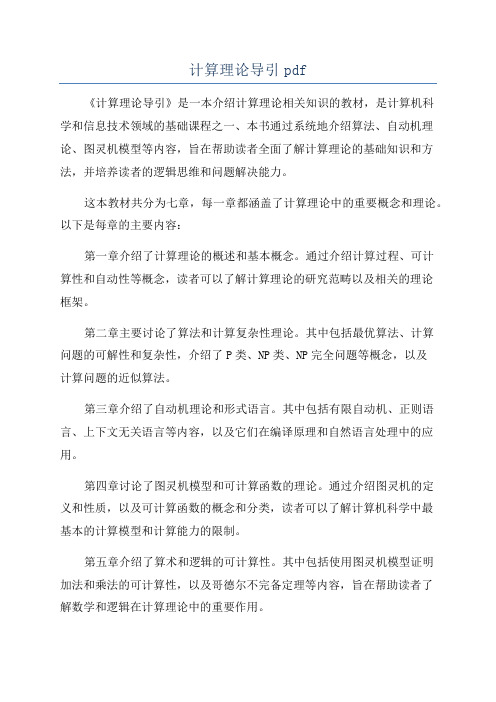
计算理论导引pdf《计算理论导引》是一本介绍计算理论相关知识的教材,是计算机科学和信息技术领域的基础课程之一、本书通过系统地介绍算法、自动机理论、图灵机模型等内容,旨在帮助读者全面了解计算理论的基础知识和方法,并培养读者的逻辑思维和问题解决能力。
这本教材共分为七章,每一章都涵盖了计算理论中的重要概念和理论。
以下是每章的主要内容:第一章介绍了计算理论的概述和基本概念。
通过介绍计算过程、可计算性和自动性等概念,读者可以了解计算理论的研究范畴以及相关的理论框架。
第二章主要讨论了算法和计算复杂性理论。
其中包括最优算法、计算问题的可解性和复杂性,介绍了P类、NP类、NP完全问题等概念,以及计算问题的近似算法。
第三章介绍了自动机理论和形式语言。
其中包括有限自动机、正则语言、上下文无关语言等内容,以及它们在编译原理和自然语言处理中的应用。
第四章讨论了图灵机模型和可计算函数的理论。
通过介绍图灵机的定义和性质,以及可计算函数的概念和分类,读者可以了解计算机科学中最基本的计算模型和计算能力的限制。
第五章介绍了算术和逻辑的可计算性。
其中包括使用图灵机模型证明加法和乘法的可计算性,以及哥德尔不完备定理等内容,旨在帮助读者了解数学和逻辑在计算理论中的重要作用。
第六章讨论了计算的可验证性和可证明性。
其中包括证明系统、不可判定问题和可证明性形式语言等内容,引导读者理解计算理论中证明和验证的概念以及相关的理论。
第七章介绍了复杂性理论和计算复杂性的研究。
其中包括计算问题的难度分类、NP完全性、多项式时间归约等内容,以及复杂性理论在实际问题中的应用和意义。
《计算理论导引》是一本较为全面的教材,适合计算机科学和信息技术相关专业的本科生和研究生学习。
通过阅读本书,读者可以了解计算理论的基本概念和理论,掌握相关的方法和技术,并进一步深入研究计算理论领域的前沿问题。
计算理论个人总结
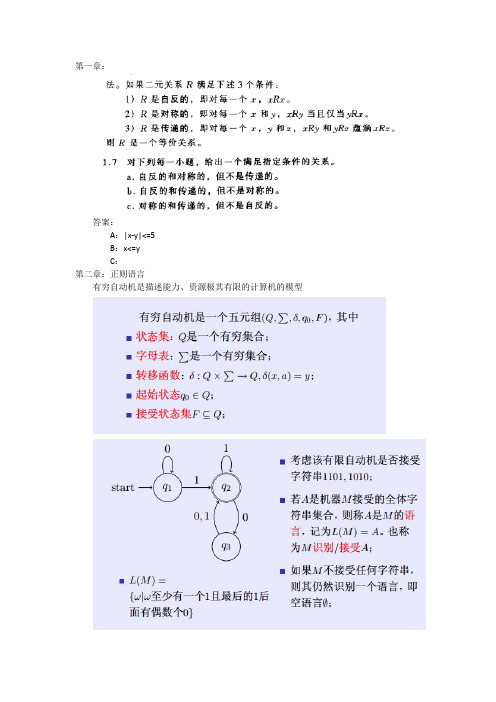
第一章:答案:A:|x-y|<=5B:x<=yC:第二章:正则语言有穷自动机是描述能力、资源极其有限的计算机的模型2.4 画出识别下述语言的DFA的状态图。
a){w | w从1开始以0结束}b){w | w 至少有3个1}c) {w | w 含有子串0101}d) {w | w 的长度不小于3,且第三个符号为0}e) {w | w 从0开始且为奇长度,或从1开始且为偶长度}或f) {w | w 不含子串110}g) {w | w 的长度不超过5}h){w | w 是除11和111以外的任何字符}i){w | w 的奇位置均为1}j) {w | w 至少含有2个0,且至多含有1个1}k) {ε,0}n) 除空串外的所有字符串0,12.12 使用定理2.19中给出的构造,把下图中的两台非确定型有穷自动机转换成等价的确定型有穷自动机。
a),b),解:a),b)2.17利用泵引理证明下述语言不是正则的。
a. A 1={0n 1n 2n| n ≥0}。
证明:假设A 1是正则的。
设p 是泵引理给出的关于A 1的泵长度。
令S=0p 1p 2p,∵S 是A 1的一个成员且S 的长度大于p ,所以泵引理保证S 可被分成3段S=xyz 且满足泵引理的3个条件。
根据条件3,y 中只含0,xyyz 中,0比1、2多,xyyz 不是A 1的成员。
违反泵引理的条件1,矛盾。
∴A 1不是正则的。
a, bb. A2={www | w∈{a,b}*}.证明:假设A2是正则的。
设p是泵引理给出的关于A2的泵长度。
令S=a p ba p ba p b,∵S是A2的一个成员且S的长度大于p,所以泵引理保证S可被分成3段S=xyz且满足泵引理的3个条件。
根据条件3,y中只含a,所以xyyz中第一个a的个数将比后两个a的个数多,故xyyz不是A2的成员。
违反泵引理的条件1,矛盾。
∴A2不是正则的。
c. A3={a2n | n≥0}.(在这里,a2n表示一串2n个a .)证明:假设A3是正则的。
正则函数的用法和意义
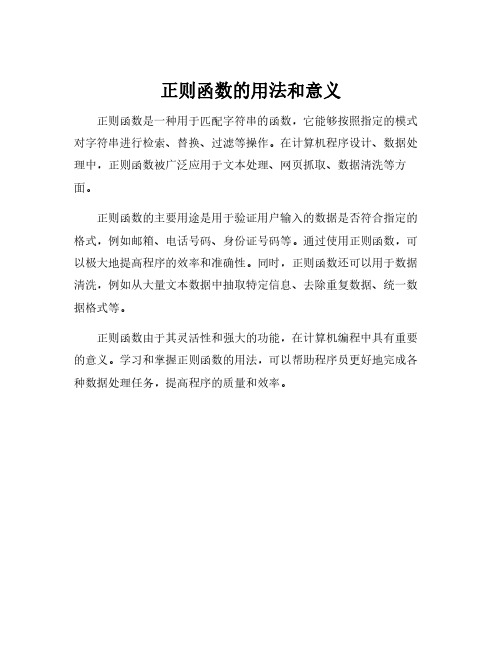
正则函数的用法和意义
正则函数是一种用于匹配字符串的函数,它能够按照指定的模式对字符串进行检索、替换、过滤等操作。
在计算机程序设计、数据处理中,正则函数被广泛应用于文本处理、网页抓取、数据清洗等方面。
正则函数的主要用途是用于验证用户输入的数据是否符合指定的格式,例如邮箱、电话号码、身份证号码等。
通过使用正则函数,可以极大地提高程序的效率和准确性。
同时,正则函数还可以用于数据清洗,例如从大量文本数据中抽取特定信息、去除重复数据、统一数据格式等。
正则函数由于其灵活性和强大的功能,在计算机编程中具有重要的意义。
学习和掌握正则函数的用法,可以帮助程序员更好地完成各种数据处理任务,提高程序的质量和效率。
计算理论——正则语言

正则运算
定理 正则语言类在连接运算下封闭。 1.13
证明思路 按照定理1.12 证明思路试一下。 输入:M1接受第一段且 M2 接受第二段时,M才接受;
? M不知道在什么地方将它的输入分开 (什么地方第一段结束,第二段开始)
20
举例
Consider the concatenation: 考虑下列连接 {1,01,11,001,011,…} • {0,000,00000,…} (That is: the bit strings that end with a “1”, followed by an odd number of 0’s.) Problem is: given a string w, how does the automaton know where the L1 part stops and the L2 substring starts? 如何知道L1 何处停止? L2 何处开始?切分问题。
0,1 1
q4
不确定性表现:
• q11 Y ? Y有两个可能状态: • 导致 q2 自动漂移到 q3
q1,q2
是否接受 “0110” 和 “1”
0110——q1 q1 q2 q3 q4 q4
1——{q1, q2 ,q3}
24
非确定性
例1.14 设 A 是 {0, 1} 上倒数第三个符号为 1 的所有字符串组 成的语言,构造非确定性自动机。
一个字符串,并且 wi 是字母表 的成员。如果存在 Q 中的
状态序列 r0, r1, … , rn,满足下列条件: 1) r0 = q0
2) (ri , wi+1) = ri+1 , i = 0, 1, …, n–1
计算理论定理定义总结

定义1.1:有穷自动机是一个 5 元组 ( Q, ∑, δ, q0, F ),其中(1) Q 是一个有穷集合,称为状态集。
(2) ∑是一个有穷集合,称为字母表。
(3) δ: Q→∑⨯Q是转移函数。
(4) q0∈Q 是起始状态。
(5) F⊆Q 是接受状态集。
定义1.7:如果一个语言被一台有穷自动机识别,则称它是正则语言。
DFA和NFA的区别:1、DFA每个状态对于字母表中的每个符号总是恰好有一个转移箭头射出。
NFA一个状态对于字母表中的每一个符号可能有0个1个或多个射出的箭头;2、在DFA中,转移箭头上的标号是取自字母表的符号。
而NFA的箭头可以标记字母表中的符号或ε。
定义1.17:非确定型有穷自动机 (NFA) 是一个 5 元组( Q, ∑, δ, q0, F ),其中(1) Q 是有穷的状态集。
(2) ∑是有穷的字母表。
(3) δ: Q⨯∑ε→P(Q)是转移函数。
(4) q0∈Q 是起始状态。
(5) F⊆Q 是接受状态集。
正则表达式的形式化定义:称 R 是一个正则表达式,如果 R 是(1) a,这里a 是字母表∑中的一个元素;(2) ε;(3) ∅(4) R1∪R2,这里 R1 和 R2 是正则表达式;(5) R1︒R2 ,这里 R1 和 R2 是正则表达式;(6) R1* ,这里 R1 是正则表达式;定义1.33:GNFA M = (Q, ∑, δ, qstart, qaccept)(1)Q 是有穷的状态集。
(2) ∑是输入字母表。
(3) δ:(Q-{qaccept})⨯(Q-{qstart}) →R 是转移函数。
(4) qstart 是起始状态。
(5) qaccept 是接受状态。
其中 R 是正则表达式。
定理1.37(泵引理):若 A 是一个正则语言,则存在一个数p (泵长度) 使得,如果s是 A 中任一长度不小于p的字符串,那么s 可以被分成 3 段,s = xyz,满足下述条件:(1) 对于每一个i≥0, xyiz∈A ;(2) | y | > 0;(3) | xy | ≢p上下文无关文法:(1) 写下起始变元——第一条规则左边的变元。
正则语言和非正则语言
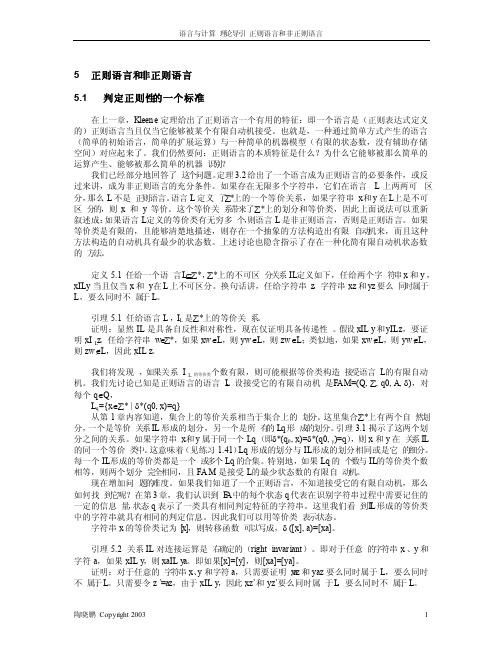
5 正则语言和非正则语言5.1 判定正则性的一个标准在上一章,Kleene定理给出了正则语言一个有用的特征:即一个语言是(正则表达式定义的)正则语言当且仅当它能够被某个有限自动机接受。
也就是,一种通过简单方式产生的语言(简单的初始语言,简单的扩展运算)与一种简单的机器模型(有限的状态数,没有辅助存储空间)对应起来了。
我们仍然要问:正则语言的本质特征是什么?为什么它能够被那么简单的运算产生、能够被那么简单的机器识别?我们已经部分地回答了这个问题。
定理3.2给出了一个语言成为正则语言的必要条件,或反过来讲,成为非正则语言的充分条件。
如果存在无限多个字符串,它们在语言L上两两可区分,那么L不是正则语言。
语言L定义了∑*上的一个等价关系,如果字符串x和y在L上是不可区分的,则x和y等价。
这个等价关系带来了∑*上的划分和等价类,因此上面说法可以重新叙述成:如果语言L定义的等价类有无穷多个,则语言L是非正则语言,否则是正则语言。
如果等价类是有限的,且能够清楚地描述,则存在一个抽象的方法构造出有限自动机来,而且这种方法构造的自动机具有最少的状态数。
上述讨论也隐含指示了存在一种化简有限自动机状态数的方法。
定义5.1 任给一个语言L⊆∑*,∑*上的不可区分关系IL定义如下,任给两个字符串x和y,xILy当且仅当x和y在L上不可区分。
换句话讲,任给字符串z,字符串xz和yz要么同时属于L,要么同时不属于L。
引理5.1 任给语言L,I L是∑*上的等价关系。
证明:显然IL是具备自反性和对称性,现在仅证明具备传递性。
假设xILy和yILz,要证明xIL z。
任给字符串w∈∑*,如果xw∈L,则yw∈L,则zw∈L;类似地,如果xw∉L,则yw∉L,则zw∉L,因此xILz。
计算理论导引总结

6
计算模型—上下文无关文法
上下文无关文法:是一个 4 元组 ( V, , R, S )
(1) V 是一个有穷集合,称为变元集。 (2) 是一个与 V 不相交的有穷集合,称为终结符集。 (3) R 是一个有穷规则集,每条规则由一个变元和一个由变元及终结 符组成的字符串构成。 (4) SV 是起始变元。
L 类 NL 类、 NL 完全性、 NL 等于 coNL
17
复杂性理论—难解性
层次定理的含义:定理中的每一个都能证明时间和空间复杂性类不全 相同,它们形成了一个层次结构,其中时空界限较大的类比时空界限 较小的类包含更多的语言。 相应的概念和结论 在相对化方法中,将修改计算模型,给图灵机一些本质上是“免费” 的信息。依据实际提供给它的信息,图灵机就可能比以前更轻松地解 决某些问题。 电路复杂性 布尔电路、电路族、…… 3SAT 是 NP 完全的
SPACE(f(n)) ={ L | L是被 O(f(n)) 空间的确定型图灵机判定的语言}
NSPACE(f(n)) = { L | L是被 O(f(n)) 空间的非确定型图灵机判定的语言} 萨维奇定理:对于任何函数 f : NR+ ,其中 f(n) n,NSPACE( f(n) ) SPACE( f 2(n) )。 P NP PSPACE=NPSPACE EXPTIME PSPACE完全的、 PSPACE难的 TQBF={< >| 是真的全量词化的布尔公式} PSPACE 完全的
15
复杂性理论—时间复杂性
NP中问题举例。
CLIQUE = { <G, k > | G 是包含 k 团的无向图} SUBSET-SUM
NP完全性: NP 中的某些问题的复杂性与整个类的复杂性 相关联。这些问题中任何一个如果存在多项式时间算法,那 么所有 NP 问题都是多项式时间可解的。 语言 A 称为多项式时间映射可归约到语言 B,记为A≤pB, 若存在多项式时间可计算函数 f : **,对于每一个 w, 有 w∈A f(w)∈B。 如果语言 B 满足下面两个条件,就称为NP完全的:
正则函数方法
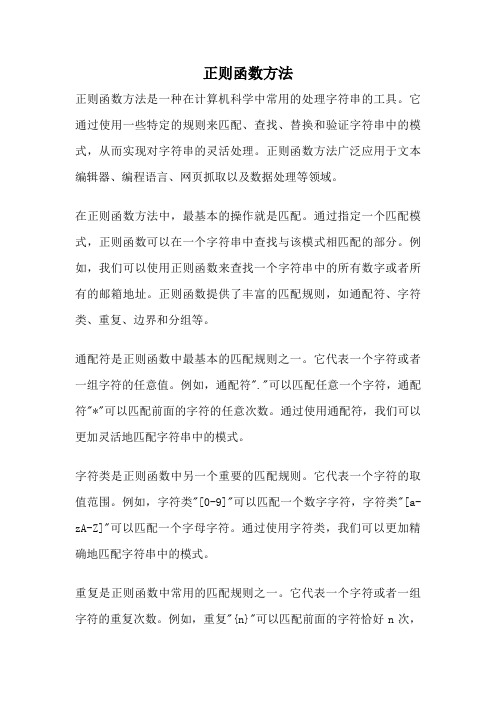
正则函数方法正则函数方法是一种在计算机科学中常用的处理字符串的工具。
它通过使用一些特定的规则来匹配、查找、替换和验证字符串中的模式,从而实现对字符串的灵活处理。
正则函数方法广泛应用于文本编辑器、编程语言、网页抓取以及数据处理等领域。
在正则函数方法中,最基本的操作就是匹配。
通过指定一个匹配模式,正则函数可以在一个字符串中查找与该模式相匹配的部分。
例如,我们可以使用正则函数来查找一个字符串中的所有数字或者所有的邮箱地址。
正则函数提供了丰富的匹配规则,如通配符、字符类、重复、边界和分组等。
通配符是正则函数中最基本的匹配规则之一。
它代表一个字符或者一组字符的任意值。
例如,通配符"."可以匹配任意一个字符,通配符"*"可以匹配前面的字符的任意次数。
通过使用通配符,我们可以更加灵活地匹配字符串中的模式。
字符类是正则函数中另一个重要的匹配规则。
它代表一个字符的取值范围。
例如,字符类"[0-9]"可以匹配一个数字字符,字符类"[a-zA-Z]"可以匹配一个字母字符。
通过使用字符类,我们可以更加精确地匹配字符串中的模式。
重复是正则函数中常用的匹配规则之一。
它代表一个字符或者一组字符的重复次数。
例如,重复"{n}"可以匹配前面的字符恰好n次,重复"{m,n}"可以匹配前面的字符至少m次,最多n次。
通过使用重复,我们可以更加精确地匹配字符串中的模式。
边界是正则函数中用于限定匹配范围的规则。
它代表一个字符或者一组字符的边界位置。
例如,边界"^"可以匹配字符串的开头,边界"$"可以匹配字符串的结尾。
通过使用边界,我们可以更加精确地限定匹配范围。
分组是正则函数中常用的匹配规则之一。
它代表一个字符或者一组字符的组合。
例如,分组"(abc)"可以匹配字符串中的"abc",并将其作为一个整体进行处理。
第二章、正则语言
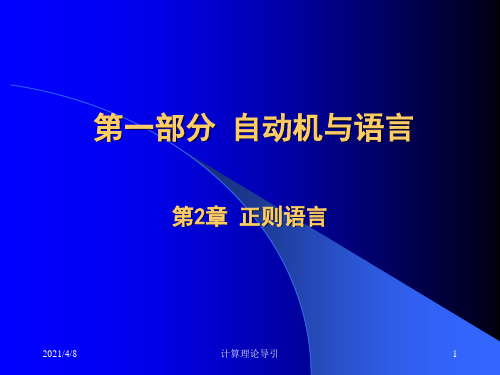
向左进入q1状态、或者向右进入r1状态。如果输入串的第一个
符号是a,那么它向左走并且当输入串以a结束时接受。类似地,
如果第一个符号是b,那么它向右走并且当输入串以b结束时接
受。 M4接受开头和
2021/4/8
计算理论导引
8
2.1.1 有穷自动机的形式定义-1
需要形式的定义
1. 形式定义是精确的。它能消除有关在一台有穷自动 机中任何不明确的疑点。
2. 形式定义提供了一种表示方法。而好的表示方法有 助于思考和清楚地表达你的思想。
形式定义把一台有穷自动机描述成以下5部分的表:
状态集、输入字母表、动作规则、起始状态以及接
2021/4/8
计算理论导引
4
2.1 有穷自动机-3
从数学的角度观察有穷自动机。
图2-4叫做M1的状态图。它有三个状态,记作q1 ,q2 ,q3。 起始状态q1用一个指向它的无出发点的箭头表示。 接受(终结)状态q2带双圈。 从一个状态指向一个状态的箭头叫做转移。
2021/4/8
计算理论导引
5
2.1 有穷自动机-4
1) 开始时处于状态q1 。 2) 读到1,沿着转移从q1 到 q2 。 3) 读到1,沿着转移从q2 到 q2 。 4) 读到0,沿着转移从q2 到 q3。 5) 读到1,沿着转移从q3 到 q2 。 6) 输出为接受(因为在输入串的末端M1 处在接受状态q2 )。
2021/4/8
计算理论导引
7
2.1 有穷自动机-6
2021/4/8
计算理论导引
3
2.1 有穷自动机-2
这个控制器是一台只有一位存储的计算机,它能够记录控制 器处于2个状态中的哪一个状态。
- 1、下载文档前请自行甄别文档内容的完整性,平台不提供额外的编辑、内容补充、找答案等附加服务。
- 2、"仅部分预览"的文档,不可在线预览部分如存在完整性等问题,可反馈申请退款(可完整预览的文档不适用该条件!)。
- 3、如文档侵犯您的权益,请联系客服反馈,我们会尽快为您处理(人工客服工作时间:9:00-18:30)。
qS
RR
qA
计算理论 wbfeng@
8
Proof Idea of Lemma c2.32 给机造表达式
, ep69, cp41
Proof idea (given a DFA M):
Construct an equivalent GNFA M‟ with k2 states Reduce one-by-one the internal states until k=2 逐个等价地减少状态,把内部的表达式变大 This GNFA will be of the form
Hence: RE NFA = DFA GNFA RE 它们的表达能 力等价
2016/5/26 计算理论 wbfeng@ 13
Nonregular Languages §1.4 ep 77
学,然后知”不足”,正则语言表达能力有限 绝大多数语言是NRL
Which languages cannot be recognized by finite automata? Example: L={ 0n1n | nN } NRL • „Playing around‟ with FA convinces you that the „finiteness‟ of FA is problematic for “all nN” • The problem occurs between the 0n and the 1n
思想:言多必复 :设一个罗嗦老太婆, 有n个论点,当说 话多于n句时,至少有一个地方在打圈, (发言激动时尤其 如此),以后遇此,可笑谈:泵定理其作用了。 正则语言是靠打圈,才描述无限集合的
2016/5/26 计算理论 wbfeng@ 3
Thm 1.28: RL ~ RE ep66
cp40(读一下)
Thm 1.28 L is RL theห้องสมุดไป่ตู้e exists RE E such that L=E 通常 L={ ..|….} E形如 (a+b)C+(d.g)*
•分两部 •1 RL 有 DFA M识别(定义),把DFA 转化称广义的GNFA •2 把广义的GNFA转化成正则表达式 RE •下页先引入广义的GNFA •普通的NFA中一个边相当于一个语句 •广义的GNFA 自动机的边可以是正则表达式(自动机),相 当相当于 程序可以调用(子)程序
2016/5/26
(无穷) 集合表达式 有限字母 有限运算 构造,可计算 We need to prove both ways: 左边 右边 • If a language is described by a regular expression, then it is regular (Lemma 1.29)上次实际上已证 左边 右边 •(Last week we saw how we can convert a regular expression R into an NFA M such that L(R)=L(M))上次已完 成FA的确定化 • Today we do the second part: 左边 右边, 给机造表达式 •If a language is regular, then it can be described by a regular expression (Lemma 1.32)
The regular language L(M) equals the language L(R) of the regular expression R
2016/5/26 计算理论 wbfeng@ 12
Regular Languages = Regular Expressions ep74 cp45 Let R be a regular expression, then there exists an NFA M such that L(R) = L(M) 正则有DFA
The language L(M) of a DFA M is equivalent to a language L(M‟) of a GNFA = M‟, which can be converted to a two-state M‟‟ DFA等价于GNFA
The transition qstart R qacceptof M‟‟ obeys L(R) = L(M‟‟) GNFA等价于正则语言
2016/5/26 计算理论 wbfeng@ 2
Regular Expressions 正则表达式
(Def. 1.26 中文:定义1.26 ) ep64 cp38
递归法下定义,适合本身是递归结构的对象,构造性的
Given an alphabet , R is a regular expression if 1. R = a, with a 2. R = 递归基础 3. R = 4. R = (R1R2), with R1 and R2 regular expressions 5. R = (R1R2), with R1 and R2 regular expressions 6. R = (R1*), with R1 a regular expression 递归结构,增加 一个运算符号 的 构造方法
- Connect qstart to earlier q1:
qS
q1
qj
qA - Connect old accepting states to qaccept
qi
- Complete missing transitions by - Join multiple transitions:合并标号
•要证明它不是NRL需要泵定理引入泵定理
• Informal: the memory of a FA is limited by the the number of states |Q|, 原因,FA的软硬件太少
2016/5/26 计算理论 wbfeng@ 14
将讨论 Pumping 定理
计算理论 wbfeng@
5
Generalized NFA 给机造表达式 ep70-73 ,
cp41-42
Generalized nondeterministic finite automaton M=(Q, , , qstart, qaccept) with • Q finite set of states 状态 不包括终点 • the input alphabet • qstart the start state 下一状态, 不包括起点 • qaccept the accept state • :(Q\{qaccept})(Q\{qstart}) R the transition function • (R is the set of regular expressions over ) • 惟一区别 自动机的边是 RE (子程序,子自动机)
This regular expression R will be such that L(R) = L(M)
qS
R
qA
2016/5/26
计算理论 wbfeng@
9
DFA M Equivalent GNFA M’
给机造表达式 ep73 cp42
Let M have k states Q={q1,…,qk} - Add two states qaccept and qstart 加首 尾 补空边
2016/5/26
qj
qi
1
0
qj
becomes
计算理论 wbfeng@
qi 01
qj
10
Remove Internal state of GNFA
给机造表达式 ep73
If the GNFA M has more than 2 states, „rip‟ internal qrip to get equivalent GNFA M‟ by: - Removing state qrip: Q‟=Q\{qrip} 逐步减少内态 -Changing the transition function by ‟(qi,qj) = (qi,qj) ((qi,qrip)((qrip,qrip))*(qrip,qj))
第二讲课程 • Chapter 1: • RL = Regular Languages, • nonregular languages
• RL pumping lemma
• Chapter 2: • Context-Free Languages (CFLs)
2016/5/26
计算理论 wbfeng@
2016/5/26
计算理论 wbfeng@
6
Example GNFA 与ep70图稍有不同
0110
0
qS
子自动机 01*
qA
0* 11
2016/5/26 计算理论 wbfeng@ 7
Characteristics of GNFA’s
Let M be DFA with k states
ep69
此页可略
Create equivalent GNFA M‟ with k+2 states Reduce in k steps M‟ to M‟‟ with 2 states The resulting GNFA describes a single regular expressions R
法则:用力拉首尾,拓扑变形。以星换圈,以并 换 多路
for every qiQ‟\{qaccept} and qjQ‟\{qstart}
R1 q rip
qi
R4
2016/5/26
R2 R3 = qi
R4(R1R2*R3)
qj
11
